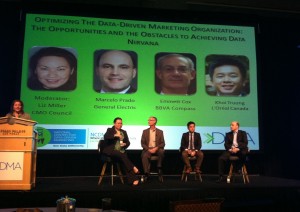The following post originally appeared on the DMA Advance blog, republished here with permission and gratitude. It was written by Stephanie Miller, VP at DMA and Chair of the Program Committee for their conference, NCDM13: Where Marketing Meets Big Data.
 The secret glue between IT and marketing departments is big data. ”This is equal parts obstacle and opportunity,” said Liz Miller, VP of the CMO Council in the luncheon keynote at the NCDM13 conference.
The secret glue between IT and marketing departments is big data. ”This is equal parts obstacle and opportunity,” said Liz Miller, VP of the CMO Council in the luncheon keynote at the NCDM13 conference.
Despite the historical friction between the departments, CMO Council research shows that BOTH marketing and IT share the goal of breaking down the functional silos to get to the data and provide business insights. ”A collaboration is born!” she said.
This merging of interests emphasizes a widespread theme of the conference: That math is a big and important part of marketing. Without it, marketing organizations will fail. The trick, however, is to attract and retain great analytics talent.
The panel Liz moderated included three marketing leaders from very different industries who discussed their strategies for optimizing analytics-based marketing. Their comments included:
Emmett Cox of BBVA Compass:
- We find that people respond to the bright shiny object of big data. It often prevents us from using the data we have. There is a lot of insight from the data you have.
- The demand for curious and smart analysts is huge, and the supply is low. The technology changes so fast, our marketing goals change so fast, the aspirations of our analysts change so fast and the way we use data changes so fast. The universities are not able to keep up. Analysts have a lot of options. The key is to keep the talent you have curious and engaged.
- We don’t try to compete on salary. We focus on the benefits of our organization – global, cross-functional, career paths to leadership. This is how we create the team of the future. If they want to work at Google or Amazon, we have a hard time convincing them that our glamour is just as meaningful.
Khoi Truong, L’Oreal Canada
- We trained a number of people in analytics, and for the others who did not want to learn, we created a dashboard. We take a purposeful approach to analytics training to help build a culture of data-driven marketing.
- We know that we have to create opportunities to engage our people in the business, and help them see where their work makes a difference.
- We need a data-driven and analytics infused approach because we want to understand not just what she is buying, but where, and how often. That cross-channel and multi-retail environment experience must be seamless.
- Talent retention for us is letting people work on the cool stuff.
Marcelo Prado, GE Analytics & Measurement
- We are discussing with customers about who owns the data, what are the challenges ahead, and how GE can serve them better. That is a new way of product innovations for us. In fact, we recently launched a “beta” with a customer that was not a perfect product, but was a Minimally Viable Product. For a product-centric culture like GE, this was very hard and new for us. However, we are getting very positive feedback form customers that iterative, collaborative product development is appealing.
- There are two questions that you must ask to set priorities: Does it align with strategy? and What is the ROI? Projects do not need to be big. Gain some small victories and get people engaged.
“In five to ten years you can’t be a CMO without a pit stop in Analytics,” Liz declared. It seems all evidence is certainly pointing in that direction.
